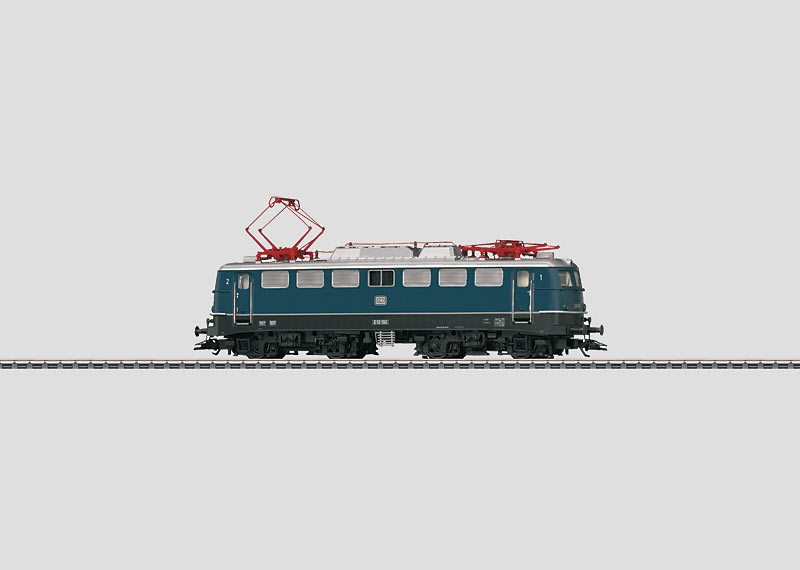Electric Locomotive.

| Article No. | 39110 |
|---|---|
| Gauge | H0 |
| Design type | 1:87 |
| Era | III |
| Kind | Electric Locomotives |
Highlights
- Completely new tooling for the class E 10 / E 40.
- Metal construction.
- High efficiency, compact design Softdrive Sine propulsion.
- mfx decoder and a sound generator included.
Product description
Model: The locomotive has an mfx digital decoder and comes from the factory with sound functions that can be turned on and off. It also has Softdrive Sine high-efficiency propulsion and a compact design, maintenance-free motor, centrally mounted. 4 axles powered through cardan shafts. Traction tires. The triple headlights (maintenance-free, warm white LEDs) and dual red marker lights (maintenance-free red LEDs) will work in conventional operation, and can be controlled digitally. The locomotive has separately applied metal grab irons. The engineer's cabs have interior details including a separately applied speed control wheel. The locomotive has separately applied roof walks. Length over the buffers 18.9 cm / 7-7/16".
Publications
- New items brochure 2009 - Product programme 2009/2010 - Product programme 2010/2011Prototype information
The E 10 – 50 Years and Still Not Tired. After the founding of the German Federal Railroad, the most important goal for the new firm was to renew the worn out motive power roster. An essential objective was to replace economically expensive steam motive power with diesel and electric locomotives. For that reason the German Federal Railroad's committee responsible for motive power decided in 1950 on a standardization program that comprised 4 different types with essentially the same components. After intensive testing with 5 pre-production class E 10.0 locomotives, the class E 10.1 to E 10.3 was selected for express train service. A total of 379 units were to be delivered to the German Federal Railroad and were built starting in 1956 in several production runs by the firms Krauss-Maffei, Krupp, Henschel-Werke (mechanical part) as well as SSW (Siemens-Schuckert-Werke), AEG, and BBC (electrical part). A welded box-style body with simple, later double lamps, and vent grills rested on welded trucks of box-style construction with truck center pins. Starting with road number E 10 288, the elegant “pant's crease” locomotive body of the E 10.12 was also used with the standard E 10, which was then designated as the class E 10.3. The locomotives were equipped with indirect working Knorr design air brakes; for switching they were equipped with direct working auxiliary brakes and also with electric resistance brakes coupled to the air brakes. The E 10 was also equipped with the rubber ring spring propulsion proven on the pre-production locomotives and four type WB 372 14-pole traction motors, which were used on later locomotive classes such as the class 111 and class 151. The transformers were the first regular production units in Germany to have high voltage control and were cooled with oil. A relay system with 28 speed steps was connected to the transformers. The E 10 was also equipped with a form of automatic control, i.e. the locomotive engineer selected the speed step, and the relay system accelerated up to the desired setting. The engineer's cabs also had mechanical and electrical safety equipment that was adapted to new standards over the years; the engineer could also now sit down in the cab to run the train. These locomotives weighed 85 metric tons, measured 16,490 mm / 54 feet 1-3/16" in length, had a maximum speed of 140 km/h / 87 mph, and had a continuous performance rating of 3,700 kilowatts / 4,961.78 horsepower. Over the course of many years of use the external appearance of the locomotives changed due to numerous rebuilding and modernization programs as well as because of new paint schemes, the designation of the class (from 1968 on as the class 110), and the area of use. In the first years the E 10 was the backbone of the express train service until faster, more powerful locomotives such as the class E 03/103 and then the class 101 supplanted them. Currently, the majority of the remaining units are used in regional service.
Features
Warning
| Control Unit | Mobile Station | Mobile Station 2 | Central Station 1/2 | Central Station 3/2 | |
|---|---|---|---|---|---|
| Headlight(s) | X | X | X | X | X |
| Blower motors | X | X | X | X | X |
| Locomotive whistle | X | X | X | X | X |
| Direct control | X | X | X | X | X |
| Headlight(s): Cab2 End | X | X | X | X | |
| Headlight(s): Cab1 End | X | X | X | X |